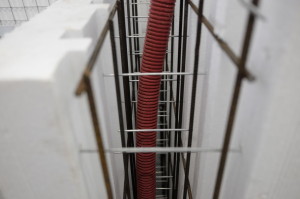 Structural engineers are making great strides in developing earthquake resistance in new buildings, and making existing structures better able to withstand the stress of earthquakes.
Structural engineers are making great strides in developing earthquake resistance in new buildings, and making existing structures better able to withstand the stress of earthquakes.
According to the National Earthquake Information Center, there are an average of 20,000 earthquakes somewhere in the world every year. Only a small percentage are noticeable, and most last only a few seconds. However, a large quake can last 10 to 30 seconds. Major quakes have major consequences, including property destruction and loss of life.
In Utah, earthquakes can happen in any part of the state, at any time of year in any kind of weather.
They’re impossible to predict, so the challenge for structural engineers is to find a way for buildings to resist the stress and shock earthquakes bring.
How earthquakes affect buildings
Buildings are generally made with a great resistance to vertical forces — gravity pulling on their own mass. However, most are not as well equipped to withstand horizontal forces.
Earthquakes produce shock waves that travel horizontally, unevenly, and in several directions. The intense side-to-side shaking moves walls, floors, beams, columns at different rates and different directions, causing them to separate and break.
Building earthquake resistance
No building can be completely immune to damage from earthquakes. But they can be made more resistant to the stresses. Most codes stipulate that buildings be made to withstand the largest earthquake that is likely to occur at that location.
Ancient architects could only try to build structures as stiff and strong as possible. Today’s approach, however, is to make the buildings more flexible to survive the shaking of an earthquake. This strategy is to allow them to sustain an acceptable level of damage that is not catastrophic, so that as much as possible of the building survives, and fewer collapses endanger lives.
Reinforcement
The first step is increasing the ability of a structure to resist damage caused by shock, movement and stress.
Today’s concrete, made according to building codes, has been shown to be highly resistant to a lot of earthquake stress. But sometimes it needs a little help.
Shear walls, which are steel frames with diagonal cross braces, are flexible, and can transfer movement away from the building to the foundation.
Moment-resisting frames allow the structure to bend while keeping joints rigid.
Flexible materials
The key is ductility, or flexibility — the ability of the building materials to distort in shape without catastrophic breakdown, and then return to their original shape.
Structural steel can be shaped to allow bending in response to earthquake stress without breaking. Wood, especially processed or manufactured wood, has high strength relative to its weight and is also showing ductility in experiments.
Innovative new materials like shape memory alloys can take great amounts of stress and distortion, and then return to their original shape.
Wrapping fiber-reinforced polymer films around beams and columns has been shown to increase their strength and ductility up to 38 percent.
Isolation and damping
Structural engineers use two broad strategies:
- isolation — separate critical areas of a structure from the moving, shaking ground
- vibration control or damping — minimize the forces that reach the built structure, and therefore the deformation that results.
One method of isolation is to construct the building on top of flexible pads made of steel, rubber and lead. During the earthquake, the foundation moves with the ground, but the flexible joint isolates the superstructure so the structure remains steady.
Damping acts like a shock absorber in a car, absorbing at least some of the shock forces and slowing down the movement of the structure. There are different ways to accomplish this. For example, oil-filled pistons attached to beams convert the motion of the building into heat. This dissipates the energy of the shock waves to a level the building’s structure can withstand.
Taller buildings and skyscrapers use a suspended form of damping. A large, heavy ball is suspended by steel cables from the top of the building with a hydraulic system. As the building begins to sway during an earthquake, the ball acts like a pendulum. It moves in the opposite direction of the building, stabilizing the structure.
An experimental method is constructing 100 concentric rings made of plastic and concrete around the foundation of the building. The thinking is that this will channel seismic forces away from the building, deflecting them away from the building or into the ground beneath.
Retrofitting existing buildings
McNeil Engineering recently retrofitted an unreinforced masonry hospital building at Fort Lewis to make it more resistant to seismic shock as well as explosions.
The challenge was to improve the resistance of this older building without changing its exterior, or reducing its usefulness after the changes. It had to meet building code requirements, as well as the Department of Defense’s Force Protection requirements.
We did the analysis for seismic retrofit and blast resistant design, and prepared detailed recommendations for the construction crew. The result is a safer, more durable and still completely usable hospital building.
Visit our structural engineering projects page for more examples of our work.








